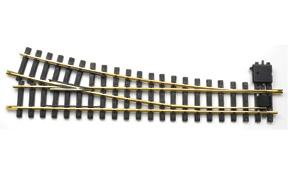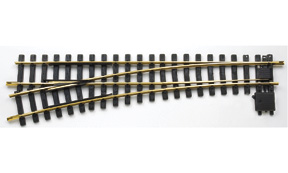Looking pros and cons for both or against each other. Thank you
cheers
Looking pros and cons for both or against each other. Thank you
cheers
Hey Richard, I think you’ll only get pros as far as the LGB 18000 switches. I have used several different manufacturers switches on my layout and although I still have several Aristo Craft #6 switches on my layout all the new additions are LGB 18000. Both because of reliability and cost. My double crossover and my new “Y” are all LGB. I also had several #6 aluminum switches made by Bruce at Switch Crafters that worked well, but with our winters they moved to much and came loose so I have moved them indoors.
I’ve been able to purchase the LGB switches anywhere from $82.00 to $90.00 each which is a lot cheaper then what you can find any of the old Aristo, Poke’s Next Generation, or USA #6 switches. Just how things have worked out for me.
The diverging track on the LGB is curved, where a #6 diverging track is straight, if that makes a difference to you.
A #6 will take up less space.
The LGB is almost bullet proof.
In addition to what Steve stated:
Looking at the LGB 18000 series track, the R5 switches may not be a direct drop-in replacement for Aristo or USA Trains #6 switches. From my experience the #6 seems closer to fitting within a 20 foot diameter circle compared to the LGB R5 that is described to fit in a 15.5 foot circle. This could be a problem for established layouts.
Curve Track, R5:
LGB 18000 Curved Track, R5, 15 Degree
“24 pieces needed to make a complete, 15.5 foot diameter circle”

Switch, Right & Left, R5:
“Straight: 600 mm. Curve…, R5, 15°. Included manual drive can be installed on either side. Convertible to electric with 12010.”
LGB 18050 Manual Switch, Right, R5

LGB 18150 Manual Switch, Left, R5

-Ted
The LGB is about a #5 frog, a bit “tighter” than a #6. All else being equal, I go for the #6.
The Aristo quality does not match the LGB, but they can be made into “good citizens”. Also the Aristo frog is all metal, so no stalling on short wheelbase locos (when the Aristo microswitch is working).
Greg
Thank you all for your thoughts. Chuck do you have any 6 wheel truck engs. if so how well do they run thru that crossover ?
thank you
cheers
As to the Aristo #6 switch, its plastic bedding that the rails and parts are attached establishes the spacing distance between the rails. For the Aristo #6 switch, I found the rails to be under gauged as per NMRA specs. Since Aristo wheels are typically under gauged, too, you would not notice a problem, but for some other product brands the wheels can ride up, particularly in the path where the point rails rest against the stock rails. I mitigated this problem by carefully grinding off some material from the mating surfaces of both point rails and stock rails. There are other issues to “fix” with the Aristo #6, too, particularly, its frog channel being too deep and its guard rails. Aristo and Train Li use to offer an insert to put in the frog channel to keep wheels from dropping into it, but they are no longer available.
The guard rail fix is in an vignette hosted for me by Greg E. on his Web site, title: Aristo-Craft #6 Turnout issues including Guard Rail Fix
If you are still in the planning stages of a layout, the Aristo #6 Wye is much better to use since its rail spacing is OK, and it has a much shorter frog.
As to using the Aristo #6 in a crossover pair, it’s best to use a straight section of track butted between the diverging sections. I used a short 6 inch straight section of track that also established a parallel track spacing of about 7 inches.
Aristo 2-8-8-2 Mallet on #6 crossover shown below.

Three Aristo Dash -9s having 6 wheel trucks traversing the #6 crossover shown below.

-Ted
Thanks Ted it sure sounds like you went to great lengths to make that #6 work for you. Have you ever looked at a usa #6?
thanks
cheers
Richard,
No, I don’t have a USA Trains #6 switch because it’s only made in brass. Though my under house layout uses Aristo brass track and switches, when I got to building the outdoor layout, I started using stainless steel since I have track power (it doesn’t oxidize like brass). Aristo made both brass and SS switches. I also have a couple Train Li nickle plated “R7” switches outdoors.
-Ted
Richard,
I have 6 USA #6 switches on my layout. They have been flawless performers for over 8 years.
Doc Watson
Hi Richard, to answer your question about 6 wheel truck engines. Yes, several club members have run their equipment on my layout that has 6 wheel trucks through the LBG double crossover. The crossover is an Aristo Craft 30 degree. Currently the LGB switch machines are manual, but the plan is to replace them with electronic switch motors this spring and control them with my Revo system. Of course like the real railroads, you don’t go through any switch or crossover at high speed because you’re just asking for a derailment.
Steve mentioned earlier that a #6 switch takes up less space. That’s not true for the Aristo Craft #6 as they are the same length as an Aristo Craft 3’ piece of straight for a direct swap. The LGB 18000 switches are shorter. And I agree with Steve, that the LGB 18000 switches are bullet proof.
For my, I want reliability so I can have fun running my trains and not always having to fix something, but that’s just me. That’s why the curved wooden trestle that weather, time, and my dog chewed up was replaced with a retaining wall, dirt fill, and new track. No more maintenance, just run time.
What is the length of the LGB 18000 turnout from the tip of the points to the tip of the frog.
Thanks
Stan
Chuck Inlow said:
Hi Richard, to answer your question about 6 wheel truck engines. Yes, several club members have run their equipment on my layout that has 6 wheel trucks through the LBG double crossover. The crossover is an Aristo Craft 30 degree. Currently the LGB switch machines are manual, but the plan is to replace them with electronic switch motors this spring and control them with my Revo system. Of course like the real railroads, you don’t go through any switch or crossover at high speed because you’re just asking for a derailment.
Steve mentioned earlier that a #6 switch takes up less space. That’s not true for the Aristo Craft #6 as they are the same length as an Aristo Craft 3’ piece of straight for a direct swap. The LGB 18000 switches are shorter. And I agree with Steve, that the LGB 18000 switches are bullet proof.
For my, I want reliability so I can have fun running my trains and not always having to fix something, but that’s just me. That’s why the curved wooden trestle that weather, time, and my dog chewed up was replaced with a retaining wall, dirt fill, and new track. No more maintenance, just run time.
I was afraid that I wasn’t very clear. What I meant was that a #6 switch did not occupy as much width (measured stock track to stock track on the diverging end of the switch) as the curved 1800 switch, allowing for more prototypical spacing of a yard. Sorry for the confusion.
so if you use a LGB 1800 right hand switch, do you need a straight track and then a left hand curve to bring a siding parrallel with the main line, to keep away from the dreaded s curves close together, where if you use a #6 then you would only need a slight left curve to bring it parallel without a s curve to worry about. Or is the curve slight enough to not worry about.
Pete I don’t have a answer but i do know the 1800 comes with a short piece of track.
cheers
richard